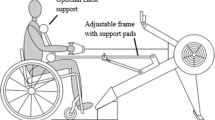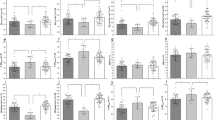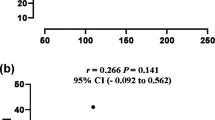Abstract
Study design:
Cross-sectional single-subject design.
Objectives:
To determine whether leg vascular occlusion (LEVO) augment arm cycling (ACE) peak oxygen uptake in spinal cord-injured individuals.
Setting:
University Hospital, Norway.
Methods:
Fifteen individuals with C4 to T12 spinal cord injury (SCI) were recruited and divided into two groups: injury above (SCI-high, n=8) or below (SCI-low, n=7) the T6 level. Peak oxygen uptake (VO2peak) was measured during (1) ACE combined with LEVO, (2) ACE alone and (3) ACE combined with functional electrical stimulation cycling (FES hybrid cycling).
Results:
In the SCI-high group, VO2peak and peak Watt during ACE with LEVO were higher than ACE alone: 20.0 (±5.0) versus 17.6 (±5.0) ml kg−1 min−1 (P=0.006), and 72.5(±32) versus 80.0 (±34) Watt (P=0.016), respectively. However, FES hybrid cycling VO2peak was significantly higher than ACE with LEVO: 24.4 (±4.1) versus 20.0 (±5.0) ml kg−1 min−1 (P=0.006). In the SCI-low group, there was no difference in VO2peak and related parameters between the three modalities.
Conclusions:
For spinal cord-injured individuals with injury level above T6 (high) in the present study, LEVO combined with ACE augment VO2peak. However, this acute increase in VO2peak was lower than when FES cycling was combined with ACE. These findings may have future implications for exercise prescription for spinal cord-injured individuals.
Similar content being viewed by others
Log in or create a free account to read this content
Gain free access to this article, as well as selected content from this journal and more on nature.com
or
References
Myers J, Lee M, Kiratli J . Cardiovascular disease in spinal cord injury: an overview of prevalence, risk, evaluation, and management. Am J Phys Med Rehabil 2007; 86: 142–152.
Hamann JJ, Valic Z, Buckwalter JB, Clifford PS . Muscle pump does not enhance blood flow in exercising skeletal muscle. J Appl Physiol 2003; 94: 6–10.
Phillips WT, Kiratli BJ, Sarkarati M, Weraarchakul G, Myers J, Franklin BA et al. Effect of spinal cord injury on the heart and cardiovascular fitness. Curr Probl Cardiol 1998; 23: 641–716.
Hooker SP, Figoni SF, Rodgers MM, Glaser RM, Mathews T, Suryaprasad AG et al. Metabolic and hemodynamic responses to concurrent voluntary arm crank and electrical stimulation leg cycle exercise in quadriplegics. J Rehabil Res Dev 1992; 29: 1–11.
Brurok B, Helgerud J, Karlsen T, Leivseth G, Hoff J . Effect of aerobic high-intensity hybrid training on stroke volume and peak oxygen consumption in men with spinal cord injury. Am J Phys Med Rehabil 2011; 90: 407–414.
Donovan-Hall MK, Burridge J, Dibb B, Ellis-Hill C, Rushton D . The views of people with spinal cord injury about the use of functional electrical stimulation. Artif Organs 2011; 35: 204–211.
Houtman S, Thielen JJ, Binkhorst RA, Hopman MT . Effect of a pulsating anti-gravity suit on peak exercise performance in individual with spinal cord injuries. Eur J Appl Physiol Occup Physiol 1999; 79: 202–204.
Pitetti KH, Barrett PJ, Campbell KD, Malzahn DE . The effect of lower body positive pressure on the exercise capacity of individuals with spinal cord injury. Med Sci Sports Exerc 1994; 4: 463–468.
Kaprielian R, Plyley MJ, Klentrou P, Goodman LS, Goodman JM . The effect of lower body positive pressure on the cardiovascular response to exercise in sedentary and endurance-trained persons with paraplegia. Eur J Appl Physiol 1998; 78: 141–147.
Mulcahey MJ, Gaughan J, Betz RR, Johansen KJ . The international standards for neurological classification of spinal cord injury: reliability of data when applied to children and youths. Spinal Cord 2006; 45: 452–459.
Teasell RW, Arnold JMO, Krassioukov A, Delaney GA . Cardiovascular consequences of loss of supraspinal control of the sympathetic nervous system after spinal cord injury. Arch Phys Med Rehabil 2000; 81: 506–516.
Hopman MT, Kamerbeek IC, Pistorius M, Binkhorst RA . The effect of an anti-G suit on the maximal performance of individuals with paraplegia. Int J Sports Med 1993; 14: 357–361.
ACoS Medicine. ACSM's Guidelines for Exercise Testing and Prescription, 8th edn. Wolters Kluwer Health Ltd, Pennsylvania, PA, USA, 2009.
Åstrand PO, Rodahl K, Dahl HA, Strømme SB . Textbook of Work Physiology: Physiological Bases of Exercise, 4th edn. McGraw-Hill: New York, 2003.
McArdle WD, Katch F, Katch VL . Exercise Physiology Energy, Nutrition, and Human Performance. 5th edn Lippincott Williams & Wilkins: Philadelphia, 2001.
Price M . Energy expenditure and metabolism during exercise in persons with a spinal cord injury. Sports Med 2010; 40: 681–696.
Collins EG, Gater D, Kiratli J, Butler J, Hanson K, Langbein WE . Energy cost of physical activities in persons with spinal cord injury. Med Sci Sports Exerc 2010; 42: 691–700.
Keteyian SJ, Brawner CA, Savage PD, Ehrman JK, Schairer J, Divine G et al. Peak aerobic capacity predicts prognosis in patients with coronary heart disease. Am Heart J 2008; 156: 292–300.
Myers J, Prakash M, Froelicher V, Do D, Partington S, Atwood JE . Exercise capacity and mortality among men referred for exercise testing. N Engl J Med 2002; 346: 793–801.
Kjar M, Pott F, Mohr T, Linkis P, Tornoe P, Secher NH . Heart rate during exercise with leg vascular occlusion in spinal cord-injured humans. J Appl Physiol 1999; 86: 806–811.
Tejwani NC, Immerman I, Achan P, Egol KA, McLaurin T . Tourniquet cuff pressure: the gulf between science and practice. Journal Trauma 2006; 61: 1415–1418.
Acknowledgements
We acknowledge the participation of the SCI individuals; Professor Jon Magnussen at the Department of Public Health and General Practice, NTNU, for timely and critical reading of the manuscript; and Professor Grethe Albrektsen at the Department of Cancer Research and Molecular Medicine, Unit for Applied Medical Research, NTNU, for valuable help with the statistical analyses. This work was supported by St Olav’s Hospital–Trondheim University Hospital, Liaison Committee between the Central Norway Regional Health Authority and the Norwegian University of Science and Technology, and SINTEF Unimed.
Author information
Authors and Affiliations
Corresponding author
Ethics declarations
Competing interests
The authors declare no conflict of interest.
Rights and permissions
About this article
Cite this article
Brurok, B., Tørhaug, T., Leivseth, G. et al. Effect of leg vascular occlusion on arm cycling peak oxygen uptake in spinal cord-injured individuals. Spinal Cord 50, 298–302 (2012). https://doi.org/10.1038/sc.2011.129
Received:
Revised:
Accepted:
Published:
Issue date:
DOI: https://doi.org/10.1038/sc.2011.129



